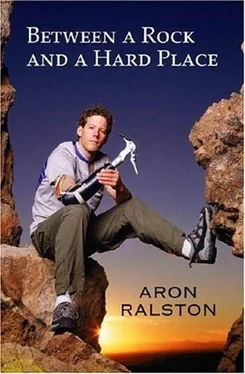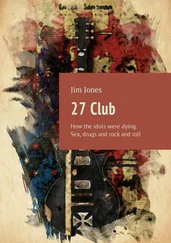A new song starts up in my headphones as I walk under the S-log, and the canyon deepens to thirty feet below the tops of the sand domes overhead.
I fear I never told you the story of the ghost / That I once knew and talked to, of whom I never boast.
The pale sky is still visible above this ten-foot-wide gash in the earth’s surface. In my path are two van-sized chockstones a hundred feet apart. One is just a foot off the sandy canyon bottom; the next sits square on the corridor floor. I scramble over both blockages. The canyon narrows to four feet wide, with undulating and twisting walls that lead me to the left then back to the right, through a straight passage, then left and right again, all the while deepening.
Colossal flood action has scooped out beach balls of rock from the sandstone walls and wedged logs thirty feet overhead. Slot canyons are the last place you want to be during a desert thunder-storm. The sky directly above the canyon might be clear, but a cloudburst in the watershed even ten or twenty miles away can maul and drown unwary canyoneers. In a flood, the rain falls faster than the ground can absorb it. In the eastern United States, it might take the ground days or weeks to reach saturation and for rivers to flood after many inches or even feet of rain. In the desert, the hard sunbaked earth acts like fired clay-tile shingles, and a flood can start from a fraction of an inch of rain that might come in five minutes from a single storm cloud. Chased off the impermeable hardscrabble, the downpour creates a surging deluge. Runoff gathers from converging drainages and quickly becomes a foot of water in a forty-foot-wide section of the canyon. That same amount of water becomes a catastrophic torrent in a confined space. Where the walls narrow to four feet, the flood turns into a ten-foot-high chaos of churning mud and debris that moves boulders, sculpts canyons, lodges drift material in constrictions, and kills anything that can’t climb to safety.
In this meandering section of the narrow canyon, silt residue from the most recent flood coats the walls to a height of twelve feet above the beachlike floor, and decades of scour marks overlay the rosy and purplish striations of exposed rock. The undulating walls distort the flat lines of the strata and grab my attention in one spot where the opposing walls dive in front of each other at a double-hairpin meander. I stop to take a few photographs. I note that the time stamp is a minute slow compared to my watch: The digital camera’s screen says it is 2:41 P.M., Saturday afternoon, April 26, 2003.
I bob my head to the music as I walk another twenty yards and come to a series of three chockstones and scramble over them. Then I see another five chockstones, all the size of large refrigerators, wedged at varying heights off the canyon floor like a boulder gauntlet. It’s unusual to see so many chockstones lined up in such evenly spaced proximity. With two feet of clearance under the first suspended chockstone, I have to crawl under it on my belly-the only time I’ve ever had to get this low in a canyon-but there is no alternative. The next chockstone is wedged a little higher off the ground. I stand and brush myself off, then squat and duck to pass under. A crawl on all fours and two more squat-and-duck maneuvers, and I’ve passed the remaining chockstones. The defile is over sixty feet deep at this point, having dropped fifty feet below the sand domes in two hundred feet of linear distance.
I come to another drop-off. This one is maybe eleven or twelve feet high, a foot higher and of a different geometry than the overhang I descended ten minutes ago. Another refrigerator chockstone is wedged between the walls, ten feet downstream from and at the same height as the ledge. It gives the space below the drop-off the claustrophobic feel of a short tunnel. Instead of the walls widening after the drop-off, or opening into a bowl at the bottom of the canyon, here the slot narrows to a consistent three feet across at the lip of the drop-off and continues at that width for fifty feet down the canyon. Sometimes in narrow passages like this one, it’s possible for me to stem my body across the slot, with my feet and back pushing out in opposite directions against the walls. Controlling this counterpressure by switching my hands and feet on the opposing walls, I can move up or down the shoulder-width crevice fairly easily as long as the friction contact stays solid between the walls and my hands, feet, and back. This technique is known as stemming or chimneying; you can imagine using it to climb up the inside of a chimney.
Just below the ledge where I’m standing is a chockstone the size of a large bus tire, stuck fast in the channel between the walls, a few feet out from the lip. If I can step onto it, then I’ll have a nine-foot height to descend, less than that of the first overhang. I’ll dangle off the chockstone, then take a short fall onto the rounded rocks piled on the canyon floor. Stemming across the canyon at the lip of the drop-off, with one foot and one hand on each of the walls, I traverse out to the chockstone. I press my back against the south wall and lock my left knee, which pushes my foot tight against the north wall. With my right foot, I kick at the boulder to test how stuck it is. It’s jammed tightly enough to hold my weight. I lower myself from the chimneying position and step onto the chockstone. It supports me but teeters slightly. After confirming that I don’t want to chimney down from the chockstone’s height, I squat and grip the rear of the lodged boulder, turning to face back upcanyon. Sliding my belly over the front edge, I can lower myself and hang from my fully extended arms, akin to climbing down from the roof of a house.
As I dangle, I feel the stone respond to my adjusting grip with a scraping quake as my body’s weight applies enough torque to disturb it from its position. Instantly, I know this is trouble, and instinctively, I let go of the rotating boulder to land on the round rocks below. When I look up, the backlit chockstone falling toward my head consumes the sky. Fear shoots my hands over my head. I can’t move backward or I’ll fall over a small ledge. My only hope is to push off the falling rock and get my head out of its way.
The next three seconds play out at a tenth of their normal speed. Time dilates, as if I’m dreaming, and my reactions decelerate. In slow motion: The rock smashes my left hand against the south wall; my eyes register the collision, and I yank my left arm back as the rock ricochets; the boulder then crushes my right hand and ensnares my right arm at the wrist, palm in, thumb up, fingers extended; the rock slides another foot down the wall with my arm in tow, tearing the skin off the lateral side of my forearm. Then silence.
My disbelief paralyzes me temporarily as I stare at the sight of my arm vanishing into an implausibly small gap between the fallen boulder and the canyon wall. Within moments, my nervous system’s pain response overcomes the initial shock. Good Christ, my hand. The flaring agony throws me into a panic. I grimace and growl a sharp “Fuck!” My mind commands my body, “Get your hand out of there!” I yank my arm three times in a naive attempt to pull it out. But I’m stuck.
Anxiety has my brain tweaking; searing-hot pain shoots from my wrist up my arm. I’m frantic, and I cry out, “Oh shit, oh shit, oh shit!” My desperate brain conjures up a probably apocryphal story in which an adrenaline-stoked mom lifts an overturned car to free her baby. I’d give it even odds that it’s made up, but I do know for certain that right now, while my body’s chemicals are raging at full flood, is the best chance I’ll have to free myself with brute force. I shove against the large boulder, heaving against it, pushing with my left hand, lifting with my knees pressed under the rock. I get good leverage with the aid of a twelve-inch shelf in front of my feet. Standing on that, I brace my thighs under the boulder and thrust upward repeatedly, grunting, “Come on…move!” Nothing.
Читать дальше












